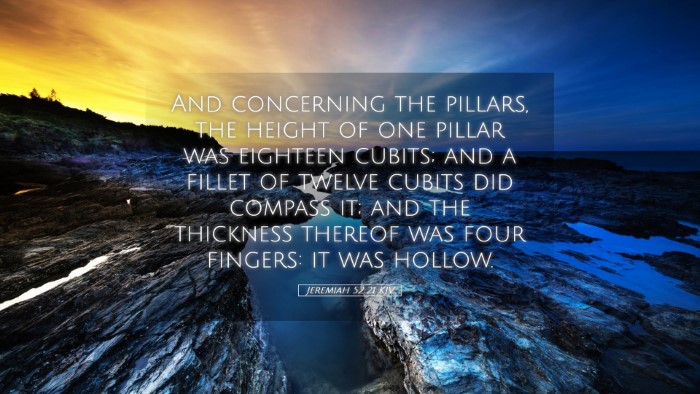Commentary on Jeremiah 52:21
Jeremiah 52:21 presents a significant moment in the reflections on the fall of Jerusalem and the scattering of Israel. This verse speaks specifically to the physical structure of Judah’s capital, with its destruction symbolizing deeper theological truths about God's judgment, covenant faithfulness, and the ultimate hope for restoration.
Text of Jeremiah 52:21
"And concerning the pillars, the height of one pillar was eighteen cubits, and its circumference was twelve cubits; and it was hollow; and its brass was thick. The second pillar also and the pomegranates were like these."
Insights from Public Domain Commentaries
1. Overview of the Verse
Matthew Henry emphasizes the meticulous description of the pillars of the Temple as symbolic of the strength and permanence of the Lord’s covenant with Israel. The measurements and materials articulate the grandeur and craftsmanship that represented the glory of God among His people.
Albert Barnes notes that the pillars, known as Jachin and Boaz, represented the majesty and stability of the divine presence. The detailed measurement hints at the significance of the architecture not merely as a construction but as a theological statement about God’s overarching sovereignty.
Adam Clarke remarks on the use of brass, highlighting both its durability and luminosity. This choice of material serves as a metaphor for God's enduring nature and the hope of restoration after judgment, underscoring a contrast between the temporal destruction of the city and the eternal faithfulness of God.
2. Theological Significance
This verse, while historical and descriptive, conveys profound theological implications. The destruction of these pillars not only marks the physical devastation of Jerusalem but also illustrates the spiritual implications of sin and rebellion against God.
God's Judgment
The fate of Jerusalem was not arbitrary; rather, it was a consequence of the covenant breach. Just as the first pillar stands as a testimony to God’s establishment of His temple, its destruction speaks to God’s judgment when His people turn away from Him. Henry highlights that “the hollow pillars suggest the emptiness of false religion and the futility of relying on anything but God."
The Hope of Restoration
Despite the somber context, both Barnes and Clarke reaffirm that the narrative does not end in despair. The description of the pillars, solid and structured, serves as a reminder of what was lost but also points forward to a future restoration. The unchanged nature of God and His promises gives hope that Israel will one day be restored, both physically and spiritually.
3. The Symbolism of the Pillars
The significant height and circumference of the pillars, along with their hollow nature, merit further exploration.
- Height: The height of eighteen cubits symbolizes maturity and completeness, reflecting the idea that God’s plans for His people encompass fullness and wholeness.
- Circumference: The twelve cubits symbolize the twelve tribes of Israel, signifying God’s intimate connection with His people and the reality that their identity is tied to Him.
- Hollowness: The hollowness showcases that the true strength of a believer is not in physical structure or appearances but in the spiritual depth and relationship with God.
4. Lessons for Believers
For pastors, students, and theologians, Jeremiah 52:21 serves as a poignant reminder of the seriousness of sin and the importance of faithfulness to God.
- Embrace God’s Promises: Like the pillars that once stood with grandeur, believers are called to stand firm in God’s promises, recognizing that even in judgment, there is space for hope and renewal.
- Reflect on Spiritual Integrity: The hollowness of the pillars serves as a challenge to examine the depth of one’s spiritual walk. Believers must avoid superficiality and seek a true, vibrant relationship with God that withstands trials.
- Remember the Cost of Disobedience: As this passage illustrates the consequences of turning from God, it serves as a solemn reminder that faithlessness can lead to dire outcomes. Regular self-examination is vital for a healthy relationship with God.
Conclusion
Jeremiah 52:21 encapsulates both the tragedy of loss and the promise of redemption, making it a rich source of reflection for all believers. The pillars of the Temple may have fallen, but they stand as enduring symbols of God’s covenant—a covenant that points to both judgment and grace. Through this verse, we are reminded that in our lowest moments, God's faithfulness remains, inviting us to restoration and hope.


